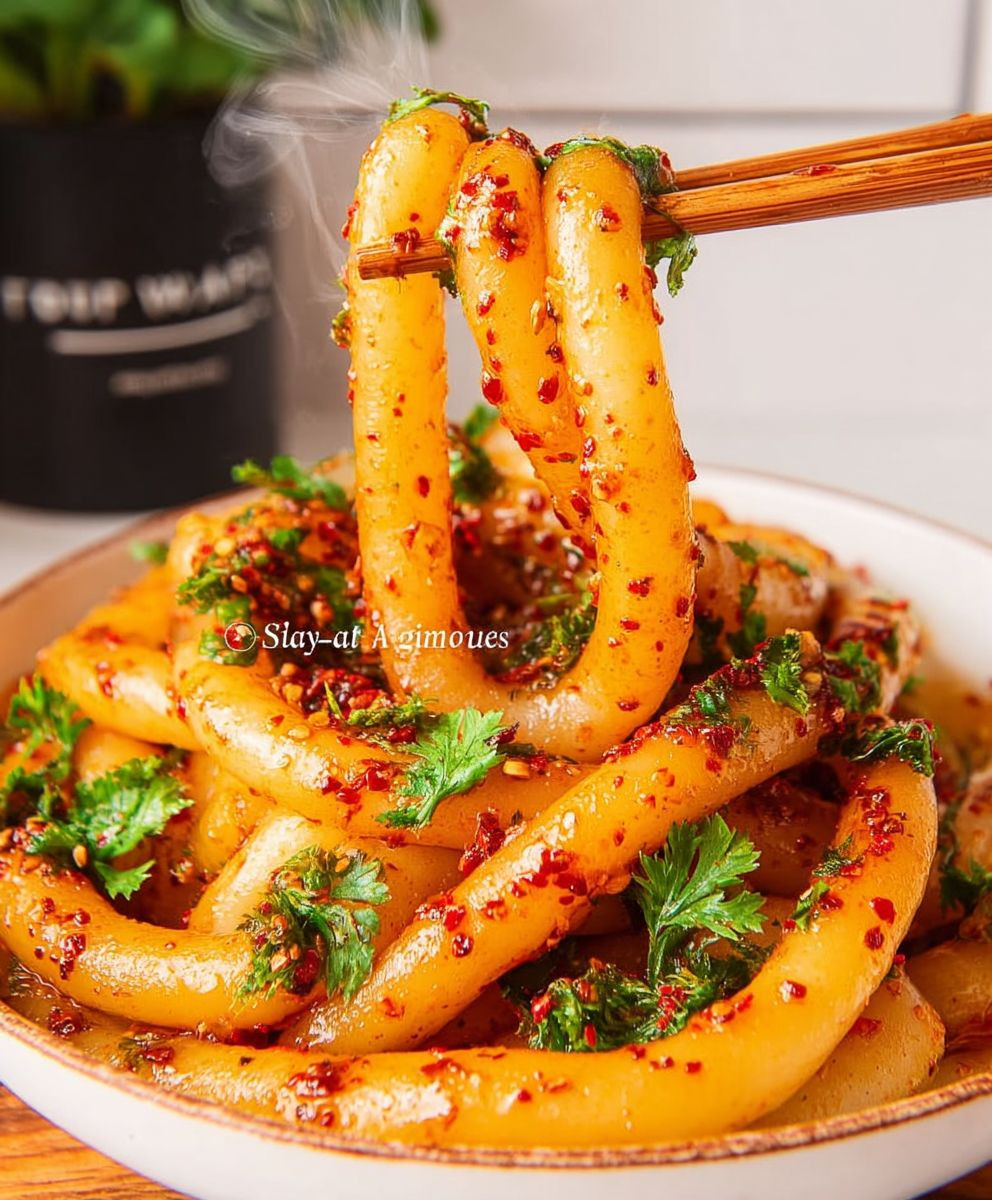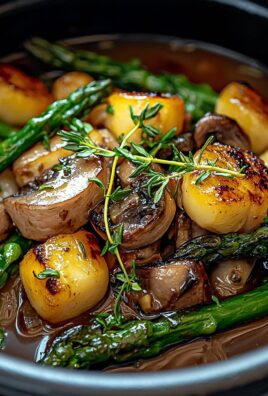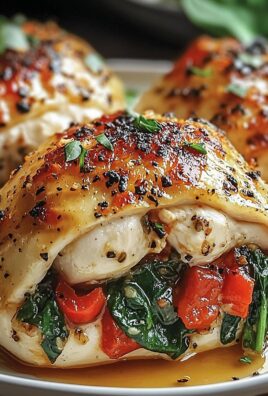Spicy Potato Noodles: Prepare to embark on a culinary adventure that will ignite your taste buds! Imagine a symphony of textures – the satisfying chew of perfectly cooked potato noodles, the vibrant crunch of fresh vegetables, and a fiery kick that leaves you craving more. This isn’t just a meal; it’s an experience.
While variations exist across Asia, the concept of potato noodles, often called “Gamja Guksu” in Korean cuisine, has deep roots in resourcefulness. Potatoes, a readily available and affordable staple, were transformed into these delightful noodles, offering a hearty and satisfying alternative to wheat-based options. This dish speaks to the ingenuity of home cooks who sought to create delicious and nourishing meals from simple ingredients.
What makes spicy potato noodles so irresistible? It’s the perfect balance of flavors and textures. The slight sweetness of the potato noodles complements the savory sauce, while the spice adds an exciting dimension that keeps you coming back for more. People love this dish because it’s incredibly versatile – easily customizable with your favorite vegetables and protein. Plus, it’s relatively quick and easy to prepare, making it a fantastic option for a weeknight dinner or a flavorful lunch. Get ready to discover your new favorite comfort food!
Ingredients:
- 1 pound dried wide potato noodles (Korean or Chinese style)
- 4 tablespoons vegetable oil, divided
- 1 pound ground pork (or beef, chicken, or tofu for a vegetarian option)
- 1 medium yellow onion, thinly sliced
- 4 cloves garlic, minced
- 1 inch ginger, minced
- 2 tablespoons gochujang (Korean chili paste)
- 1 tablespoon gochugaru (Korean chili flakes), adjust to taste
- 2 tablespoons soy sauce
- 1 tablespoon rice vinegar
- 1 tablespoon sesame oil
- 1 tablespoon sugar
- 1 teaspoon black pepper
- 4 cups chicken broth (or vegetable broth)
- 1 cup napa cabbage, chopped
- 1 carrot, julienned
- 4 scallions, thinly sliced, for garnish
- Sesame seeds, for garnish
- Optional: 1/2 cup kimchi, chopped
- Optional: 1 egg, fried or soft-boiled, per serving
Preparing the Noodles:
Before we dive into the spicy goodness, let’s get the noodles ready. Potato noodles can be a bit tricky if you don’t treat them right, but don’t worry, I’ll guide you through it!
- Soak the Noodles: Place the dried potato noodles in a large bowl. Cover them completely with cold water. Let them soak for at least 30 minutes, or even up to an hour. This will help them soften up and cook evenly later. They should be pliable but still firm.
- Drain the Noodles: Once the noodles are nicely softened, drain them well in a colander. Give them a good shake to remove any excess water. Set them aside for now.
Cooking the Meat and Aromatics:
This is where the flavor party starts! We’re going to build a delicious base with the meat and aromatics.
- Brown the Meat: Heat 2 tablespoons of vegetable oil in a large wok or deep skillet over medium-high heat. Add the ground pork (or your protein of choice) and cook, breaking it up with a spatula, until it’s browned and cooked through. Drain off any excess grease.
- Sauté the Aromatics: Add the sliced onion to the wok and cook until softened and translucent, about 3-5 minutes. Then, add the minced garlic and ginger and cook for another minute until fragrant. Be careful not to burn the garlic!
- Add the Spicy Paste: Stir in the gochujang and gochugaru. Cook for about a minute, stirring constantly, to bloom the spices and release their flavor. This step is crucial for that authentic spicy kick!
Building the Sauce:
Now we’re going to create the flavorful sauce that will coat our noodles and veggies.
- Add the Liquids: Pour in the chicken broth (or vegetable broth). Bring the mixture to a simmer.
- Season the Sauce: Stir in the soy sauce, rice vinegar, sesame oil, sugar, and black pepper. Taste and adjust the seasoning as needed. You might want to add a little more gochujang or gochugaru if you like it extra spicy!
- Simmer the Sauce: Let the sauce simmer for about 5-10 minutes to allow the flavors to meld together. This will create a richer, more complex sauce.
Cooking the Noodles and Vegetables:
Time to bring it all together! We’ll cook the noodles and veggies in the flavorful sauce.
- Add the Noodles: Gently add the soaked and drained potato noodles to the wok. Use tongs to separate the noodles and ensure they are submerged in the sauce.
- Cook the Noodles: Cook the noodles according to the package directions, usually around 8-10 minutes, or until they are tender and translucent. Stir frequently to prevent them from sticking to the bottom of the wok. The sauce will thicken as the noodles cook and absorb the liquid.
- Add the Vegetables: Add the chopped napa cabbage and julienned carrot to the wok. Cook for another 3-5 minutes, or until the vegetables are tender-crisp.
- Adjust Consistency: If the sauce becomes too thick, add a little more broth to thin it out. You want the noodles to be nicely coated in a slightly saucy consistency.
Serving and Garnishing:
Almost there! Now for the final touches that will make this dish truly irresistible.
- Serve Immediately: Divide the spicy potato noodles among bowls.
- Garnish Generously: Sprinkle with sliced scallions and sesame seeds.
- Add Kimchi (Optional): If you’re using kimchi, add a spoonful to each bowl for an extra layer of flavor and spice.
- Top with an Egg (Optional): For a truly decadent experience, top each bowl with a fried or soft-boiled egg. The runny yolk will add richness and creaminess to the dish.
- Enjoy! Serve immediately and enjoy the explosion of flavors!
Tips and Variations:
- Spice Level: Adjust the amount of gochujang and gochugaru to your liking. If you’re sensitive to spice, start with a smaller amount and add more as needed.
- Vegetarian Option: Substitute the ground pork with tofu or mushrooms. Make sure to press the tofu to remove excess water before cooking.
- Protein Variations: Feel free to use other proteins like ground beef, chicken, or shrimp.
- Vegetable Variations: Add other vegetables like spinach, bean sprouts, or bell peppers.
- Noodle Type: While wide potato noodles are traditional, you can also use other types of noodles like udon or ramen.
- Make Ahead: You can prepare the sauce ahead of time and store it in the refrigerator for up to 3 days. When you’re ready to cook, simply heat the sauce and add the noodles and vegetables.
- Storage: Leftovers can be stored in the refrigerator for up to 3 days. Reheat gently in a skillet or microwave.
Why Potato Noodles?
Potato noodles, also known as glass noodles or cellophane noodles, are made from potato starch and water. They have a unique chewy texture that is perfect for absorbing sauces. They are also gluten-free, making them a great option for those with gluten sensitivities.
Gochujang and Gochugaru: The Dynamic Duo of Korean Cuisine
Gochujang is a fermented Korean chili paste that is made from red chili powder, glutinous rice, fermented soybeans, and salt. It has a complex, savory, spicy, and slightly sweet flavor. Gochugaru is Korean chili flakes that are made from sun-dried red chili peppers. It has a vibrant red color and a slightly smoky flavor. Together, gochujang and gochugaru are essential ingredients in many Korean dishes, adding depth and complexity to the flavor profile.
Serving Suggestions:
This spicy potato noodle dish is a complete meal on its own. However, you can also serve it with side dishes like kimchi, pickled radishes, or Korean cucumber salad.
Enjoy the Process!
Cooking should be fun and relaxing. Don’t be afraid to experiment with different ingredients and flavors to create your own unique version of this dish. The most important thing is to enjoy the process and share your delicious creation with friends and family!
Conclusion:
So, there you have it! This recipe for Spicy Potato Noodles is truly a game-changer. It’s quick, it’s easy, it’s packed with flavor, and it’s incredibly versatile. What more could you ask for? I genuinely believe this will become a staple in your kitchen, just like it has in mine. The combination of the chewy noodles, the fiery sauce, and the fresh toppings creates a symphony of textures and tastes that will leave you craving more.
But why is this recipe a must-try? Well, beyond the sheer deliciousness, it’s the perfect weeknight meal. You can whip it up in under 30 minutes, making it ideal for those busy evenings when you don’t have a lot of time to spend in the kitchen. Plus, it’s a fantastic way to use up any leftover vegetables you might have lurking in your fridge. Think sliced bell peppers, shredded carrots, or even some wilted spinach – they’ll all work beautifully in this dish.
And speaking of versatility, let’s talk about serving suggestions and variations. While I love this recipe as is, there are endless ways to customize it to your liking. For a heartier meal, consider adding some protein. Grilled chicken, shrimp, or tofu would all be excellent additions. If you’re feeling adventurous, you could even try adding some Korean beef bulgogi for an extra layer of flavor.
If you’re not a fan of spice, you can easily adjust the amount of gochujang to your preference. Start with a smaller amount and add more to taste. You can also add a touch of sweetness to balance the heat by adding a drizzle of honey or maple syrup. For a vegetarian or vegan option, simply omit the fish sauce and use soy sauce or tamari instead. You can also add some extra vegetables like mushrooms or broccoli for added nutrients and flavor.
Another fun variation is to experiment with different types of noodles. While I personally love using Korean sweet potato noodles (dangmyeon), you could also use udon noodles, ramen noodles, or even spaghetti. Just be sure to adjust the cooking time accordingly.
Serving Suggestions: I love serving these spicy potato noodles as a main course, but they also make a great side dish. They pair perfectly with grilled meats, roasted vegetables, or even a simple salad. You can also pack them for lunch or take them on a picnic. They’re delicious hot or cold! Garnish with extra sesame seeds, chopped green onions, and a drizzle of sesame oil for an extra touch of flavor and visual appeal. A side of kimchi is also a welcome addition to the meal.
I’m so confident that you’ll love this recipe that I urge you to give it a try. Don’t be intimidated by the ingredients list – most of them are readily available at your local grocery store or Asian market. And once you’ve made it once, you’ll realize just how easy it is to put together.
So, what are you waiting for? Head to the kitchen and get cooking! And most importantly, don’t forget to share your experience with me. I’d love to hear what you think of the recipe and any variations you might have tried. Leave a comment below or tag me on social media – I can’t wait to see your creations! I truly believe that this Spicy Potato Noodles recipe will become a new favorite in your household. Happy cooking!
Spicy Potato Noodles: A Delicious and Easy Recipe
Spicy and savory Korean potato noodles (Japchae-inspired) with ground pork, vegetables, and a fiery gochujang sauce. A comforting and customizable dish perfect for a weeknight meal.
Ingredients
- 1 pound dried wide potato noodles (Korean or Chinese style)
- 4 tablespoons vegetable oil, divided
- 1 pound ground pork (or beef, chicken, or tofu for a vegetarian option)
- 1 medium yellow onion, thinly sliced
- 4 cloves garlic, minced
- 1 inch ginger, minced
- 2 tablespoons gochujang (Korean chili paste)
- 1 tablespoon gochugaru (Korean chili flakes), adjust to taste
- 2 tablespoons soy sauce
- 1 tablespoon rice vinegar
- 1 tablespoon sesame oil
- 1 tablespoon sugar
- 1 teaspoon black pepper
- 4 cups chicken broth (or vegetable broth)
- 1 cup napa cabbage, chopped
- 1 carrot, julienned
- 4 scallions, thinly sliced, for garnish
- Sesame seeds, for garnish
- Optional: 1/2 cup kimchi, chopped
- Optional: 1 egg, fried or soft-boiled, per serving
Instructions
- Place the dried potato noodles in a large bowl. Cover them completely with cold water. Let them soak for at least 30 minutes, or even up to an hour, until pliable but still firm. Drain well in a colander.
- Heat 2 tablespoons of vegetable oil in a large wok or deep skillet over medium-high heat. Add the ground pork (or protein of choice) and cook, breaking it up, until browned and cooked through. Drain off any excess grease.
- Add the sliced onion to the wok and cook until softened and translucent, about 3-5 minutes. Add the minced garlic and ginger and cook for another minute until fragrant.
- Stir in the gochujang and gochugaru. Cook for about a minute, stirring constantly, to bloom the spices.
- Pour in the chicken broth (or vegetable broth). Bring the mixture to a simmer.
- Stir in the soy sauce, rice vinegar, sesame oil, sugar, and black pepper. Taste and adjust seasoning as needed.
- Let the sauce simmer for about 5-10 minutes to allow the flavors to meld together.
- Gently add the soaked and drained potato noodles to the wok. Use tongs to separate the noodles and ensure they are submerged in the sauce.
- Cook the noodles according to the package directions, usually around 8-10 minutes, or until they are tender and translucent. Stir frequently to prevent them from sticking. The sauce will thicken.
- Add the chopped napa cabbage and julienned carrot to the wok. Cook for another 3-5 minutes, or until the vegetables are tender-crisp.
- If the sauce becomes too thick, add a little more broth to thin it out.
- Divide the spicy potato noodles among bowls.
- Sprinkle with sliced scallions and sesame seeds.
- Add a spoonful to each bowl for an extra layer of flavor and spice.
- Top each bowl with a fried or soft-boiled egg.
- Serve immediately.
Notes
- Spice Level: Adjust the amount of gochujang and gochugaru to your liking.
- Vegetarian Option: Substitute the ground pork with tofu or mushrooms. Press the tofu to remove excess water before cooking.
- Protein Variations: Use ground beef, chicken, or shrimp.
- Vegetable Variations: Add spinach, bean sprouts, or bell peppers.
- Noodle Type: Use udon or ramen.
- Make Ahead: Prepare the sauce ahead of time and store it in the refrigerator for up to 3 days.
- Storage: Leftovers can be stored in the refrigerator for up to 3 days. Reheat gently in a skillet or microwave.





